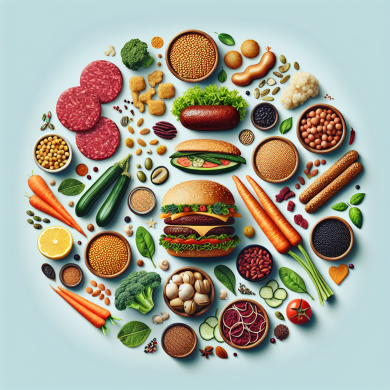### Top Vegetarian Sources for Protein Power
Introduction
In recent years, vegetarianism has gained significant traction as individuals become more health-conscious and environmentally aware. As the demand for plant-based diets continues to rise, one of the most common concerns is ensuring adequate protein intake. Proteins are vital macronutrients necessary for building muscles, repairing tissues, and producing enzymes and hormones. While many associate protein with meat and animal products, there are abundant vegetarian sources that provide ample protein to meet dietary needs. This article will explore the top vegetarian sources for protein power, offering a comprehensive guide for those seeking to maintain a balanced and nutritious diet.
Understanding Protein Needs
Before delving into specific vegetarian protein sources, it is essential to understand protein needs. The Recommended Dietary Allowance (RDA) for protein is 46 grams per day for adult women and 56 grams per day for adult men. These values can vary based on factors such as age, sex, activity level, and overall health. For individuals following a vegetarian diet, it is crucial to consume protein from a variety of sources to ensure the intake of all essential amino acids, the building blocks of protein.
Legumes: A Protein-Rich Staple
Lentils
Lentils are a versatile and nutrient-dense legume, making them a staple in many vegetarian diets. With approximately 18 grams of protein per cooked cup, lentils are an excellent source of plant-based protein. They are also rich in fiber, iron, and folate, contributing to overall health. Lentils can be used in soups, stews, salads, and even as a meat substitute in dishes like lentil burgers or “meatballs.”
Chickpeas (Garbanzo Beans)
Chickpeas are another powerhouse legume, offering about 15 grams of protein per cooked cup. They are also high in fiber and essential vitamins and minerals, including folate, phosphorus, and iron. Chickpeas can be enjoyed in a variety of forms, such as hummus, roasted snacks, or as a base for salads and curries.
Black Beans
Black beans provide approximately 15 grams of protein per cooked cup and are rich in antioxidants, fiber, and essential nutrients like folate and magnesium. These beans are incredibly versatile and can be used in a wide range of dishes, from burritos and tacos to salads and soups.
Nuts and Seeds: Protein-Packed Powerhouses
Almonds
Almonds are a convenient and protein-rich snack, offering about 6 grams of protein per ounce (about 23 almonds). In addition to protein, almonds are packed with healthy fats, fiber, vitamin E, and magnesium. They can be enjoyed raw, roasted, or used as almond butter in smoothies or spreads.
Chia Seeds
Chia seeds are tiny but mighty when it comes to protein content. With about 4 grams of protein per two tablespoons, chia seeds are also an excellent source of omega-3 fatty acids, fiber, and antioxidants. They can be added to smoothies, yogurt, oatmeal, or used to make chia pudding.
Pumpkin Seeds
Pumpkin seeds, or pepitas, provide around 7 grams of protein per ounce and are rich in magnesium, zinc, and healthy fats. They make a great topping for salads, yogurt, or oatmeal and can be eaten as a snack on their own.
Whole Grains: A Protein Source Often Overlooked
Quinoa
Quinoa is a complete protein, meaning it contains all nine essential amino acids. With about 8 grams of protein per cooked cup, quinoa is also high in fiber, magnesium, and iron. This versatile grain can be used in salads, bowls, or as a rice substitute in various dishes.
Oats
Oats are a protein-rich whole grain, providing about 6 grams of protein per half-cup serving. They are also high in fiber, specifically beta-glucan, which is beneficial for heart health. Oats can be enjoyed as oatmeal, in smoothies, or used in baking.
Farro
Farro is an ancient grain that offers about 8 grams of protein per cooked cup. It is also rich in fiber, magnesium, and iron. Farro’s chewy texture and nutty flavor make it an excellent addition to salads, soups, or as a side dish.
Dairy Alternatives: Plant-Based Protein with a Creamy Twist
Greek Yogurt
For those who include dairy in their vegetarian diet, Greek yogurt is a high-protein option, providing around 10 grams of protein per 100 grams. It is also a good source of calcium and probiotics, which support gut health. Greek yogurt can be enjoyed on its own, with fruit, or as a base for smoothies.
Tofu
Tofu, made from soybeans, is a versatile and protein-rich food, offering about 10 grams of protein per half-cup serving. It is also a good source of calcium and iron. Tofu can be used in a variety of dishes, from stir-fries and curries to smoothies and desserts.
Tempeh
Tempeh is another soy-based protein source, providing approximately 15 grams of protein per half-cup serving. It is fermented, which enhances nutrient absorption and contributes to gut health. Tempeh has a firm texture and nutty flavor, making it a great addition to sandwiches, salads, and stir-fries.
Vegetable Proteins: An Unexpected Source
Broccoli
While vegetables are not typically associated with high protein content, broccoli surprises with about 3 grams of protein per cup. It is also rich in vitamins C and K, fiber, and antioxidants. Broccoli can be steamed, roasted, or added to stir-fries and casseroles.
Spinach
Spinach provides about 5 grams of protein per cooked cup and is an excellent source of vitamins A and C, iron, and calcium. It can be used in salads, smoothies, omelets, or as a cooked side dish.
Peas
Peas offer approximately 8 grams of protein per cooked cup and are rich in fiber, vitamins A, C, and K, as well as several B vitamins. They can be added to soups, stews, salads, or enjoyed as a simple side dish.
Incorporating Vegetarian Protein Sources into Your Diet
Incorporating a variety of these protein-rich vegetarian foods into your diet can help ensure adequate protein intake while providing a diverse range of nutrients. Here are some practical tips for including these foods in your meals:
– **Breakfast:** Start your day with a protein-packed meal by adding chia seeds or almond butter to your oatmeal or smoothie. Consider a tofu scramble with spinach and tomatoes for a savory option.
– **Lunch:** Opt for a hearty salad with quinoa, chickpeas, and a variety of colorful vegetables. Add some roasted pumpkin seeds for extra crunch and protein.
– **Dinner:** Incorporate lentils or black beans into your favorite soups, stews, or curries. Try a quinoa-stuffed pepper or a tempeh stir-fry for a satisfying meal.
– **Snacks:** Keep almonds, pumpkin seeds, or Greek yogurt on hand for quick, protein-rich snacks. Hummus with raw vegetables is another nutritious option.
Conclusion
A vegetarian diet can provide ample protein when planned thoughtfully and creatively. By incorporating a diverse array of protein-rich foods such as legumes, nuts, seeds, whole grains, dairy alternatives, and vegetables, individuals can meet their protein needs while enjoying a variety of flavors and textures. Whether you are a committed vegetarian or simply seeking to reduce your meat consumption, these plant-based protein sources offer a nutritious and sustainable way to power your diet.















Add comment